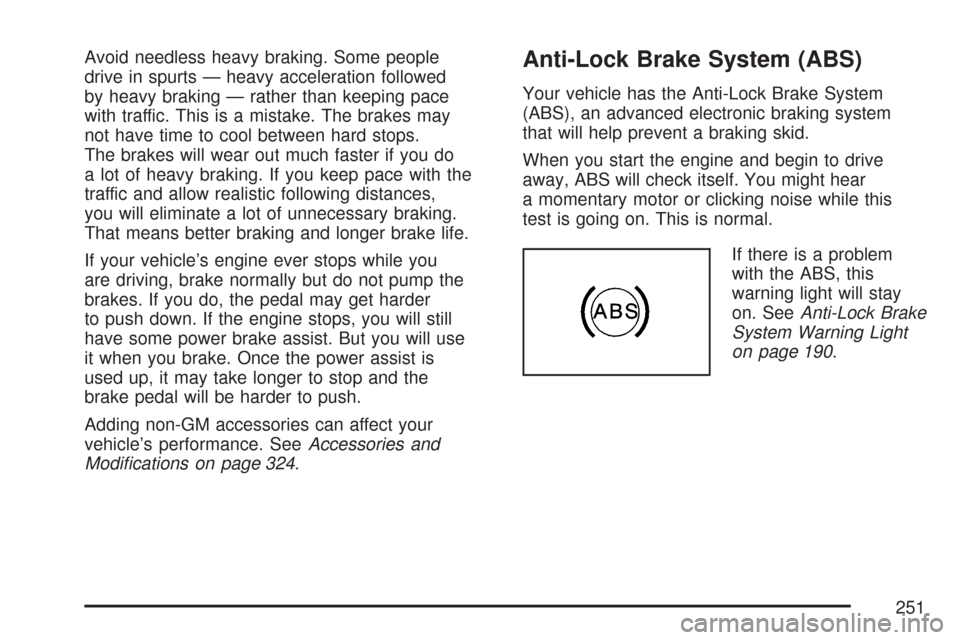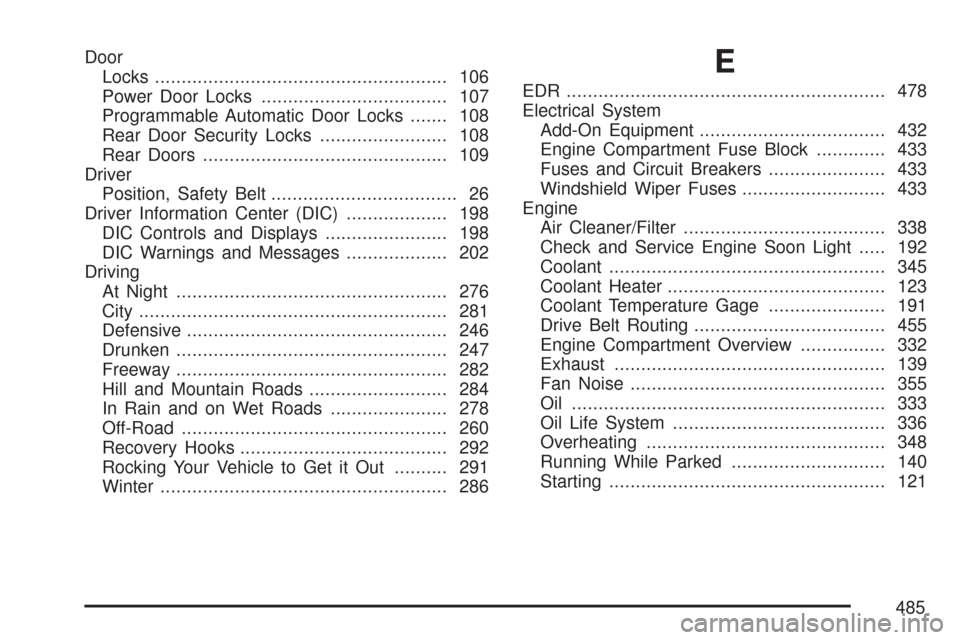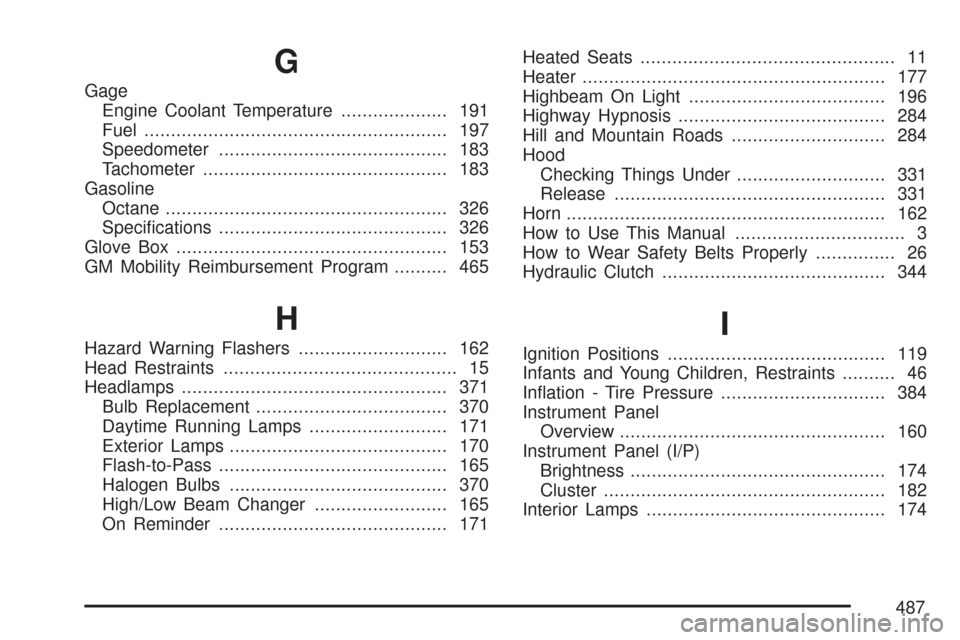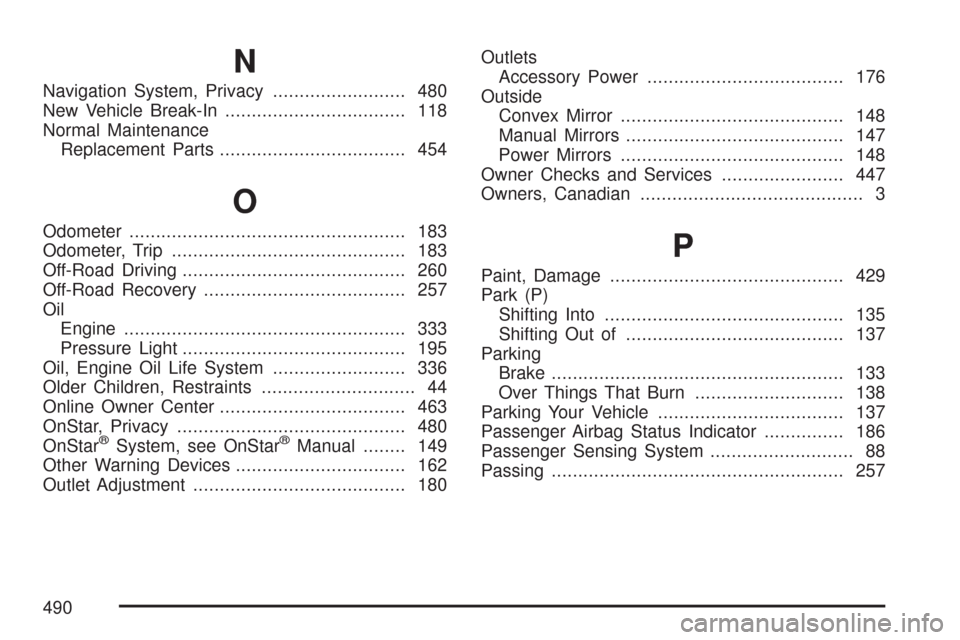check engine light CHEVROLET COLORADO 2007 1.G User Guide
[x] Cancel search | Manufacturer: CHEVROLET, Model Year: 2007, Model line: COLORADO, Model: CHEVROLET COLORADO 2007 1.GPages: 496, PDF Size: 2.7 MB
Page 251 of 496

Avoid needless heavy braking. Some people
drive in spurts — heavy acceleration followed
by heavy braking — rather than keeping pace
with traffic. This is a mistake. The brakes may
not have time to cool between hard stops.
The brakes will wear out much faster if you do
a lot of heavy braking. If you keep pace with the
traffic and allow realistic following distances,
you will eliminate a lot of unnecessary braking.
That means better braking and longer brake life.
If your vehicle’s engine ever stops while you
are driving, brake normally but do not pump the
brakes. If you do, the pedal may get harder
to push down. If the engine stops, you will still
have some power brake assist. But you will use
it when you brake. Once the power assist is
used up, it may take longer to stop and the
brake pedal will be harder to push.
Adding non-GM accessories can affect your
vehicle’s performance. SeeAccessories and
Modi�cations on page 324.Anti-Lock Brake System (ABS)
Your vehicle has the Anti-Lock Brake System
(ABS), an advanced electronic braking system
that will help prevent a braking skid.
When you start the engine and begin to drive
away, ABS will check itself. You might hear
a momentary motor or clicking noise while this
test is going on. This is normal.
If there is a problem
with the ABS, this
warning light will stay
on. SeeAnti-Lock Brake
System Warning Light
on page 190.
251
Page 283 of 496

Once you are moving on the freeway, make
certain you allow a reasonable following distance.
Expect to move slightly slower at night.
When you want to leave the freeway, move to
the proper lane well in advance. If you miss your
exit, do not, under any circumstances, stop
and back up. Drive on to the next exit.
The exit ramp can be curved, sometimes quite
sharply. The exit speed is usually posted.
Reduce your speed according to your
speedometer, not to your sense of motion.
After driving for any distance at higher speeds,
you may tend to think you are going slower
than you actually are.
Before Leaving on a Long Trip
Make sure you are ready. Try to be well rested.
If you must start when you are not fresh — such
as after a day’s work — do not plan to make
too many miles that �rst part of the journey.
Wear comfortable clothing and shoes you can
easily drive in.Is your vehicle ready for a long trip? If you keep it
serviced and maintained, it is ready to go. If it needs
service, have it done before starting out. Of course,
you will �nd experienced and able service experts
in GM dealrships all across North America. They
will be ready and willing to help if you need it.
Here are some things you can check before a trip:
Windshield Washer Fluid:Is the reservoir
full? Are all windows clean inside and outside?
Wiper Blades:Are they in good shape?
Fuel, Engine Oil, Other Fluids:Have you
checked all levels?
Lamps:Are they all working? Are the
lenses clean?
Tires:They are vitally important to a safe,
trouble-free trip. Is the tread good enough
for long-distance driving? Are the tires
all in�ated to the recommended pressure?
Weather Forecasts:What is the weather
outlook along your route? Should you delay
your trip a short time to avoid a major storm
system?
Maps:Do you have up-to-date maps?
283
Page 329 of 496

{CAUTION:
Fuel can spray out on you if you open the
fuel cap too quickly. If you spill fuel and
then something ignites it, you could be
badly burned. This spray can happen if
your tank is nearly full, and is more likely
in hot weather. Open the fuel cap slowly
and wait for any hiss noise to stop. Then
unscrew the cap all the way.
Be careful not to spill fuel. Do not top off or over�ll
the tank and wait a few seconds after you have
�nished pumping before removing the nozzle.
Clean fuel from painted surfaces as soon as
possible. SeeWashing Your Vehicle on page 426.
When replacing the fuel cap, turn it clockwise
until it clicks. Make sure the cap is fully installed.
The diagnostic system can determine if the
fuel cap has been left off or improperly installed.
This would allow fuel to evaporate into the
atmosphere. If the fuel cap is not properly installed,the FUEL CAP message will appear on the Driver
Information Center (DIC) and the check engine
light will be lit on the instrument panel cluster.
SeeDIC Warnings and Messages on page 202
andMalfunction Indicator Lamp on page 192
for more information.
{CAUTION:
If a �re starts while you are refueling,
do not remove the nozzle. Shut off the
�ow of fuel by shutting off the pump
or by notifying the station attendant.
Leave the area immediately.
Notice:If you need a new fuel cap, be sure
to get the right type. Your dealer/retailer
can get one for you. If you get the wrong type,
it may not �t properly. This may cause your
malfunction indicator lamp to light and
may damage your fuel tank and emissions
system. SeeMalfunction Indicator Lamp
on page 192.
329
Page 345 of 496

How to Check and Add Fluid
The proper �uid should be added if the level does
not reach the bottom of the diaphragm when it
is in place in the reservoir. See the instructions
on the reservoir cap.
Engine Coolant
The cooling system in your vehicle is �lled with
DEX-COOL®engine coolant. This coolant is
designed to remain in your vehicle for �ve years
or 150,000 miles (240 000 km), whichever occurs
�rst, if you add only DEX-COOL
®extended life
coolant.
The following explains your cooling system and
how to add coolant when it is low. If you have
a problem with engine overheating, seeEngine
Overheating on page 348.A 50/50 mixture of clean, drinkable water and
DEX-COOL
®coolant will:
Give freezing protection down
to−34°F (−37°C).
Give boiling protection up
to 265°F (129°C).
Protect against rust and corrosion.
Help keep the proper engine temperature.
Let the warning lights and gages work
as they should.
Notice:Using coolant other than DEX-COOL
®
may cause premature engine, heater core,
or radiator corrosion. In addition, the engine
coolant may require changing sooner, at
the �rst maintenance service after each
30,000 miles (50 000 km) or 24 months,
whichever occurs �rst. Any repairs would
not be covered by your warranty. Always
use DEX-COOL
®(silicate-free) coolant
in your vehicle.
345
Page 483 of 496

C
Calibration..........................................142, 145
California Fuel............................................. 326
California Proposition 65 Warning................ 324
Canadian Owners........................................... 3
Capacities and Speci�cations....................... 437
Carbon Monoxide..............110, 139, 286, 306
Care of
Safety Belts............................................. 425
Your CD Player........................................ 243
Your CDs ................................................. 243
CD, MP3 ..................................................... 234
Center Front Passenger Position,
Safety Belts............................................... 36
Center High-Mounted Stoplamp (CHMSL)..... 372
Chains, Tire................................................. 398
Check
Engine Light............................................ 192
Checking Things Under the Hood................ 331
Chemical Paint Spotting.............................. 430
Child Restraints
Child Restraint Systems............................. 50
Infants and Young Children........................ 46
Lower Anchors and Tethers for
Children.................................................. 56Child Restraints (cont.)
Older Children........................................... 44
Securing a Child Restraint in a
Rear Seat Position ................................. 69
Securing a Child Restraint in the
Center Front Seat Position..................... 71
Securing a Child Restraint in the
Right Front Seat Position........................ 72
Where to Put the Restraint........................ 54
Chime Level Adjustment.............................. 244
Cigarette Lighter.......................................... 177
Cleaning
Aluminum or Chrome-Plated Wheels........ 428
Exterior Lamps/Lenses............................. 426
Fabric/Carpet........................................... 423
Finish Care.............................................. 426
Inside of Your Vehicle.............................. 422
Instrument Panel, Vinyl, and
Other Plastic Surfaces.......................... 425
Leather.................................................... 424
Tires........................................................ 429
Underbody Maintenance........................... 430
Washing Your Vehicle.............................. 426
Weatherstrips........................................... 425
Windshield and Wiper Blades................... 427
483
Page 485 of 496

Door
Locks....................................................... 106
Power Door Locks................................... 107
Programmable Automatic Door Locks....... 108
Rear Door Security Locks........................ 108
Rear Doors.............................................. 109
Driver
Position, Safety Belt................................... 26
Driver Information Center (DIC)................... 198
DIC Controls and Displays....................... 198
DIC Warnings and Messages................... 202
Driving
At Night................................................... 276
City.......................................................... 281
Defensive................................................. 246
Drunken................................................... 247
Freeway................................................... 282
Hill and Mountain Roads.......................... 284
In Rain and on Wet Roads...................... 278
Off-Road.................................................. 260
Recovery Hooks....................................... 292
Rocking Your Vehicle to Get it Out.......... 291
Winter...................................................... 286E
EDR ............................................................ 478
Electrical System
Add-On Equipment................................... 432
Engine Compartment Fuse Block............. 433
Fuses and Circuit Breakers...................... 433
Windshield Wiper Fuses........................... 433
Engine
Air Cleaner/Filter...................................... 338
Check and Service Engine Soon Light..... 192
Coolant.................................................... 345
Coolant Heater......................................... 123
Coolant Temperature Gage...................... 191
Drive Belt Routing.................................... 455
Engine Compartment Overview................ 332
Exhaust................................................... 139
Fan Noise................................................ 355
Oil ........................................................... 333
Oil Life System........................................ 336
Overheating............................................. 348
Running While Parked............................. 140
Starting.................................................... 121
485
Page 487 of 496

G
Gage
Engine Coolant Temperature.................... 191
Fuel......................................................... 197
Speedometer........................................... 183
Tachometer.............................................. 183
Gasoline
Octane..................................................... 326
Speci�cations........................................... 326
Glove Box................................................... 153
GM Mobility Reimbursement Program.......... 465
H
Hazard Warning Flashers............................ 162
Head Restraints............................................ 15
Headlamps.................................................. 371
Bulb Replacement.................................... 370
Daytime Running Lamps.......................... 171
Exterior Lamps......................................... 170
Flash-to-Pass........................................... 165
Halogen Bulbs......................................... 370
High/Low Beam Changer......................... 165
On Reminder........................................... 171Heated Seats................................................ 11
Heater......................................................... 177
Highbeam On Light..................................... 196
Highway Hypnosis....................................... 284
Hill and Mountain Roads............................. 284
Hood
Checking Things Under............................ 331
Release................................................... 331
Horn............................................................ 162
How to Use This Manual................................ 3
How to Wear Safety Belts Properly............... 26
Hydraulic Clutch.......................................... 344
I
Ignition Positions......................................... 119
Infants and Young Children, Restraints.......... 46
In�ation - Tire Pressure............................... 384
Instrument Panel
Overview.................................................. 160
Instrument Panel (I/P)
Brightness................................................ 174
Cluster..................................................... 182
Interior Lamps............................................. 174
487
Page 490 of 496

N
Navigation System, Privacy......................... 480
New Vehicle Break-In.................................. 118
Normal Maintenance
Replacement Parts................................... 454
O
Odometer.................................................... 183
Odometer, Trip............................................ 183
Off-Road Driving.......................................... 260
Off-Road Recovery...................................... 257
Oil
Engine..................................................... 333
Pressure Light.......................................... 195
Oil, Engine Oil Life System......................... 336
Older Children, Restraints............................. 44
Online Owner Center................................... 463
OnStar, Privacy........................................... 480
OnStar
®System, see OnStar®Manual........ 149
Other Warning Devices................................ 162
Outlet Adjustment........................................ 180Outlets
Accessory Power..................................... 176
Outside
Convex Mirror.......................................... 148
Manual Mirrors......................................... 147
Power Mirrors.......................................... 148
Owner Checks and Services....................... 447
Owners, Canadian.......................................... 3
P
Paint, Damage............................................ 429
Park (P)
Shifting Into............................................. 135
Shifting Out of......................................... 137
Parking
Brake....................................................... 133
Over Things That Burn............................ 138
Parking Your Vehicle................................... 137
Passenger Airbag Status Indicator............... 186
Passenger Sensing System........................... 88
Passing....................................................... 257
490
Page 492 of 496

Rearview Mirror, Automatic Dimming with
Compass and Temperature Display............ 145
Rearview Mirror, Automatic Dimming
with OnStar
®, Compass and
Temperature Display................................ 142
Rearview Mirror with OnStar
®...................... 142
Rearview Mirrors......................................... 141
Reclining Seatbacks...................................... 12
Recommended Fluids and Lubricants.......... 452
Recovery Hooks.......................................... 292
Recreational Vehicle Towing........................ 300
Remote Keyless Entry (RKE) System.......... 102
Remote Keyless Entry (RKE) System,
Operation................................................. 103
Removing the Flat Tire and Installing
the Spare Tire.......................................... 404
Removing the Spare Tire and Tools............ 401
Replacement Bulbs..................................... 374
Reporting Safety Defects
Canadian Government............................. 475
General Motors........................................ 476
United States Government....................... 475Restraint System Check
Checking the Restraint Systems................. 96
Replacing Restraint System Parts
After a Crash......................................... 96
Retained Accessory Power (RAP)................ 121
Right Front Passenger Position,
Safety Belts............................................... 35
Roadside
Assistance Program................................. 466
Rocking Your Vehicle to Get it Out.............. 291
Routing, Engine Drive Belt.......................... 455
Running the Engine While Parked............... 140
S
Safety Belt
Passenger Reminder Light....................... 184
Pretensioners............................................. 43
Reminder Light........................................ 184
Safety Belts
Care of.................................................... 425
Center Front Passenger Position................ 36
492